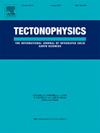Heterogeneous mineralogical composition and fault behaviour: A systematic study in ternary fault rock compositions
IF 2.7
3区 地球科学
Q2 GEOCHEMISTRY & GEOPHYSICS
引用次数: 0
Abstract
The heterogeneous mineralogical compositions of fault gouges, formed during fault evolution, influence frictional properties and slip behaviour. While the influence of individual mineral phases on friction has been extensively studied, the impact of varying systematically mineral phases in gouge mixtures on macroscopic frictional behaviour remains unclear. Thus, we performed 34 frictional experiments on fault gouges composed of three representative mineral phases: muscovite (platy phyllosilicate), quartz (granular silicate) and calcite (granular carbonate), known for their markedly distinct frictional properties. Using a biaxial rock deformation apparatus (BRAVA), we performed tests on fault gouges with grain sizes <125 μm under normal stresses of 50–100 MPa, at room temperature and water-saturated conditions. Our data indicate that the mineralogical composition of fault gouges significantly affects frictional strength, healing, and stability with a non-trivial pattern. Increasing the muscovite content leads to a decrease in frictional strength, from 0.62 for pure calcite and 0.56 for pure quartz to 0.33 of pure muscovite, along with reduced frictional healing and a velocity-strengthening behaviour. This weakening is promoted by a transition from localized deformation along discrete shear planes in granular-rich fault gouges to distributed deformation within the entire gouge layer with increasing muscovite content. At fixed muscovite content, frictional properties depend on the dominant granular phase. Calcite-dominated mixtures exhibit more marked frictional weakening rather than quartz-dominated ones, suggesting a non-linear mixing law between friction coefficient and muscovite content. This different trend is likely due to favourable conditions for fluid-assisted pressure-solution of calcite and foliation development, unlike quartz. When only the granular phases are mixed, we observe complex behaviour with the indentation of quartz into calcite, resulting in higher values of healing rates than those of pure end-member mixtures.
Our findings provide robust insights into microphysical processes strongly dependent on the complex mineralogical compositions usually observed along natural faults.
异质矿物成分与断层行为:三元断层岩成分的系统研究
断层演化过程中形成的断层沟的异质矿物成分会影响摩擦特性和滑移行为。虽然单个矿物相对摩擦的影响已被广泛研究,但断层破碎带混合物中矿物相的系统变化对宏观摩擦行为的影响仍不清楚。因此,我们对由三种具有代表性的矿物相组成的断层冲沟进行了 34 次摩擦实验,这三种矿物相分别是:褐铁矿(板状硅酸盐)、石英(粒状硅酸盐)和方解石(粒状碳酸盐),它们以明显不同的摩擦特性而闻名。我们使用双轴岩石形变仪(BRAVA),在常温和水饱和状态下,在 50-100 兆帕的法向应力作用下,对晶粒大小为 125 微米的断层破碎带进行了测试。我们的数据表明,断层破碎带的矿物成分对摩擦强度、愈合和稳定性有显著影响,且影响模式并不复杂。黝帘石含量的增加会导致摩擦强度降低,从纯方解石的 0.62 和纯石英的 0.56 降至纯黝帘石的 0.33,同时摩擦愈合能力降低,速度增强。随着白云母含量的增加,富含颗粒的断层破碎带从沿离散剪切面的局部变形过渡到整个破碎带层的分布变形,从而促进了这种削弱。在云英岩含量固定的情况下,摩擦特性取决于主要的颗粒相。以方解石为主的混合物比以石英为主的混合物表现出更明显的摩擦减弱,这表明摩擦系数与白云母含量之间存在非线性混合规律。与石英不同的是,这种不同的趋势可能是由于方解石在流体辅助下压力溶解和褶皱发展的有利条件所致。当只有颗粒相混合时,我们观察到石英压入方解石的复杂行为,导致愈合率值高于纯端部混合物的愈合率值。
本文章由计算机程序翻译,如有差异,请以英文原文为准。
求助全文
约1分钟内获得全文
求助全文
来源期刊

Tectonophysics
地学-地球化学与地球物理
CiteScore
4.90
自引率
6.90%
发文量
300
审稿时长
6 months
期刊介绍:
The prime focus of Tectonophysics will be high-impact original research and reviews in the fields of kinematics, structure, composition, and dynamics of the solid arth at all scales. Tectonophysics particularly encourages submission of papers based on the integration of a multitude of geophysical, geological, geochemical, geodynamic, and geotectonic methods
 求助内容:
求助内容: 应助结果提醒方式:
应助结果提醒方式:


